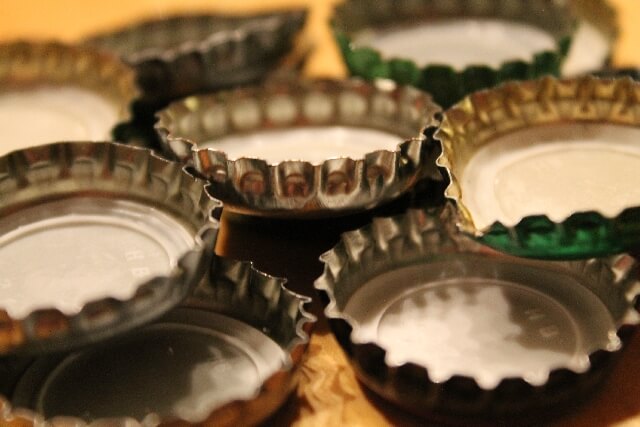Beer is a classic, refreshing drink coveted worldwide by billions of people. To put into perspective how heavy beer consumption is, picture this.
In 2018, the global beer consumption stood at over 188.7 million kiloliters which is equivalent to 240 billion 633 ml bottles.
Unluckily, with every beer bottle that is gulped down, one more cap heads over to the dumpsite.
Though locally, the effect of beer caps on the environment may seem minute, on a global scale, it is catastrophic.
That is why nowadays, beer caps are recyclable to curb pollution and reduce pressure on resources.
Continue reading this article to learn more about beer cap recycling.
Types of Recyclable Beer Caps
Most beer-producing companies package the beverage in reusable glass bottles and seal the top with a cap or crown.
The crown can be metallic or plastic.
Metallic crowns are either made of aluminum or steel because the two industrial metals are rust proof, do not introduce bad taste in the drink, and are resistant to the corrosive carbonic acid in beers.
Also, steel and aluminum caps are sturdy, easily available, and most importantly, recyclable into usable products.
Plastic caps, on the other hand, are rare in the North American market, where companies prefer pasteurized drinks, compared to the UK, where they are fairly common.
Recycling plastic caps is tricky, especially on a large scale. This is because they have a seal inside that is difficult to remove.
For that reason, only a few recycling firms will accept plastic caps.
But at home, you can use them to create unique DIY projects, decorate flower vases, photo frames, bathroom mirrors, lampstands, and even tables.
Recycling Aluminum and Steel Beer Caps
There are so many ways of recycling aluminum bottle caps at home and in recycling facilities. Here are a few of them;
- Use colorful metallic caps to make decorative pieces of art at home
Bottle caps are small, versatile, and lightweight, making them a good fit for home DIY projects. You can craft necklaces, wall art, flower vases, retro-style trays, and literally anything you can think of out of them.
However, to come up with attractive designs, you must be good at art and craft or at least be willing to learn new things.
In your DIY projects, you can use glue or resin to stick together different colored caps to form a hilarious shape or object of your choice. For example, you can stick caps on the top surface of an old table in a beautiful pattern and finish off by covering the caps with resin.
Instructables Workshop details the process of creating a cap-resin table and has even posted instructional pictures to help you understand better. Feel free to visit their website.
Another beautiful product that works well with recycled caps is nails. You can hammer caps on surfaces such as walls in a certain pattern to come up with a stunning piece of art.
A good example is crab art. Simply trace the outline of a crab on the wall or a platform. Next, hummer caps within the borders of your drawing. For claws, fold four caps twice and hammer them in place of pincers, as shown by New Things Production.
- Take beer caps to a recycling facility.
Recyclers accept most metallic caps as they can be salvaged and reused to produce various things. This reduces the rate at which dumpsites are filling up, subsequently saving the environment.
Furthermore, some recyclers pay for recyclable caps, which is a good income-earning opportunity that can bag you as much as 9 cents per cap.
Before taking the caps to a recycling facility, you need to do the following;
- Sort the crowns according to the type of metal they were made of
Separating caps according to the metal types they were made of is easy. Pour down the crowns on a flat surface, probably a mat. Then pass over a magnet.
Steel caps will be attracted and stick to the magnet leaving behind aluminum ones. Remove and put steel cups in a container, probably a can.
Repeat the process until you are sure no steel caps are left on the mat.
Pour aluminum caps into another container in preparation for transportation.
When packaging, use metallic cans of the same material the caps were made of. For instance, use steel cans for steel crowns as is to aluminum.
- Crimp the cans to seal off their content
Once the can is halfway or three-quarters full, seal off its content by crimping.
Crimping is the same as pinching together the edges of cans in an effort to close the open end.
If your can has a metallic lid, there is no need for crimping. Just fill it up with caps to the brim and twist the lid in place.
Why all the sorting and crimping?
Sorting increases the chances of every cap being recycled, while crimping prevents individual caps from falling through separating screens as they roll on the recycling conveyor belts.
Note: other than recycling companies, some bottle retailers within your localities accept beer caps under a take-back program. Just find out about their recycling policies and take your stash to them.
Why is it Important to Recycle Beer Caps?
Recycling plays a noble role in keeping the environment clean and protecting natural resources. Luckily, recycling beer caps is way more important than that.
- It protects the ecosystem and wildlife in areas where iron and aluminum used to produce beer crown is mined.
- Reduces pressure on fossil fuel during mining and processing of ores into caps. This subsequently reduces global warming and pollution.
- Saves energy. For instance, when recycling aluminum for a new product, the process consumes 5% of what it takes to mine, transport, refine, and smelting aluminum ores into finished products. Likewise, steel recycling consumes 75% less energy compared to working with virgin resources.
- Recycling is cheaper and reduces the overall cost of production.
Final Thought
Beer caps are recyclable, thanks to the materials they were made of. Recycling steel and aluminum caps can be achieved by sorting and taking them to a recycling facility.
You can also creatively craft something out of them at home.
Lastly pursuing cap-recycling endeavors is saving natural resources, reducing pollution, and protecting marine species.



